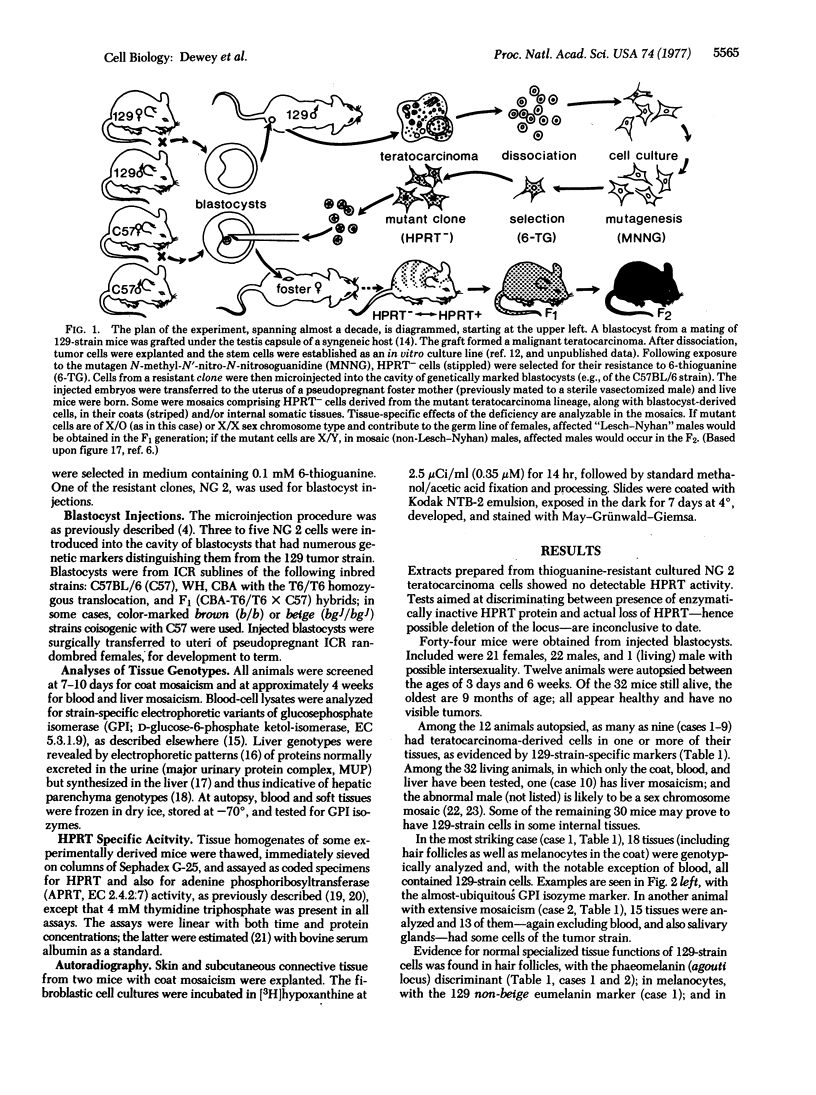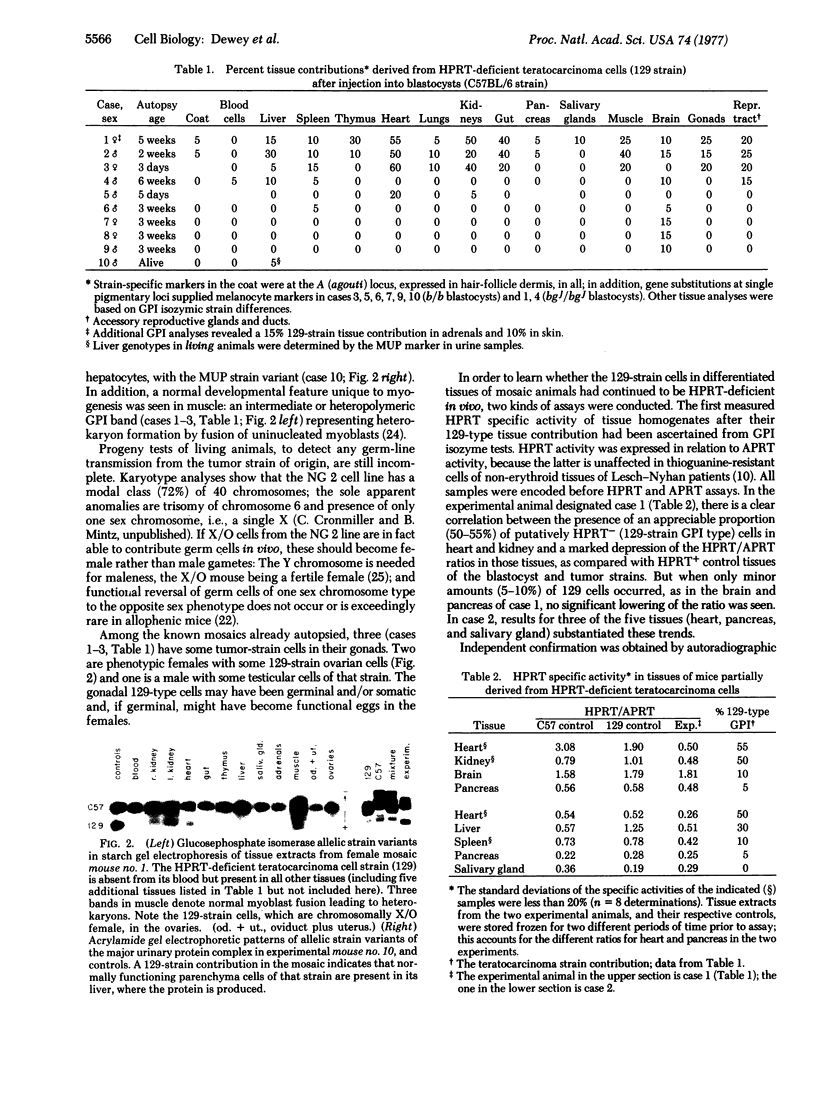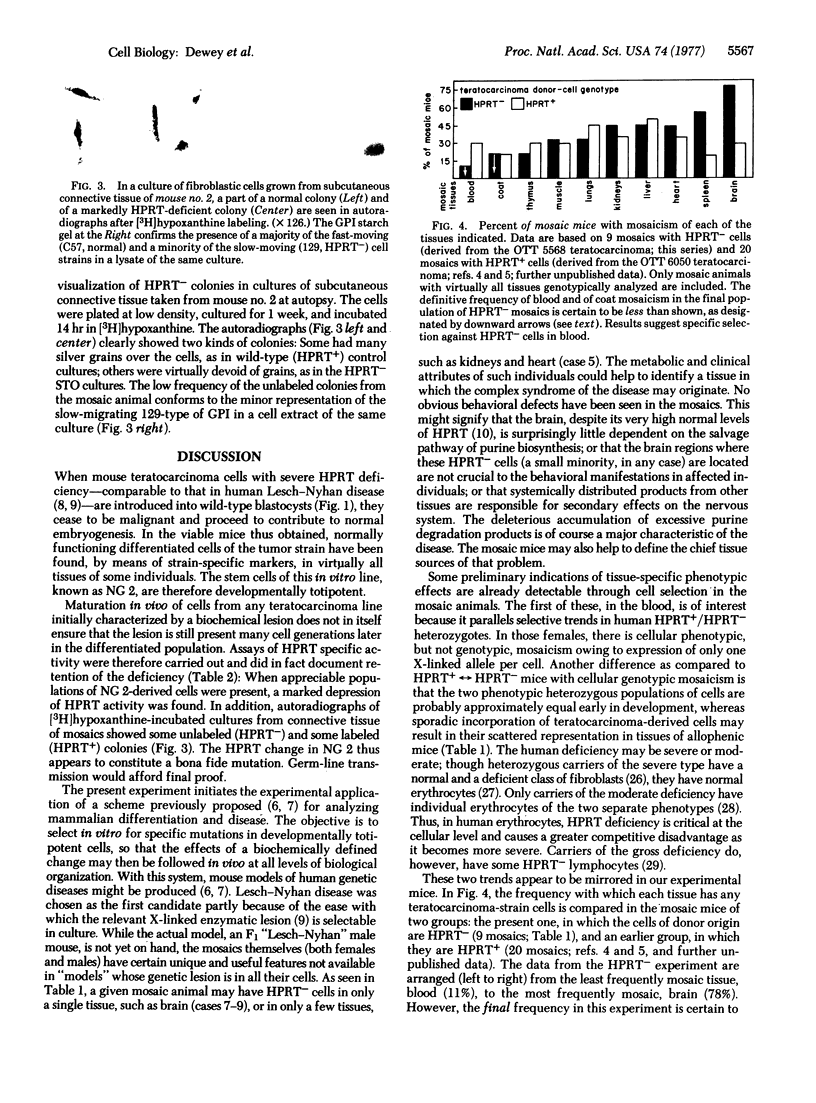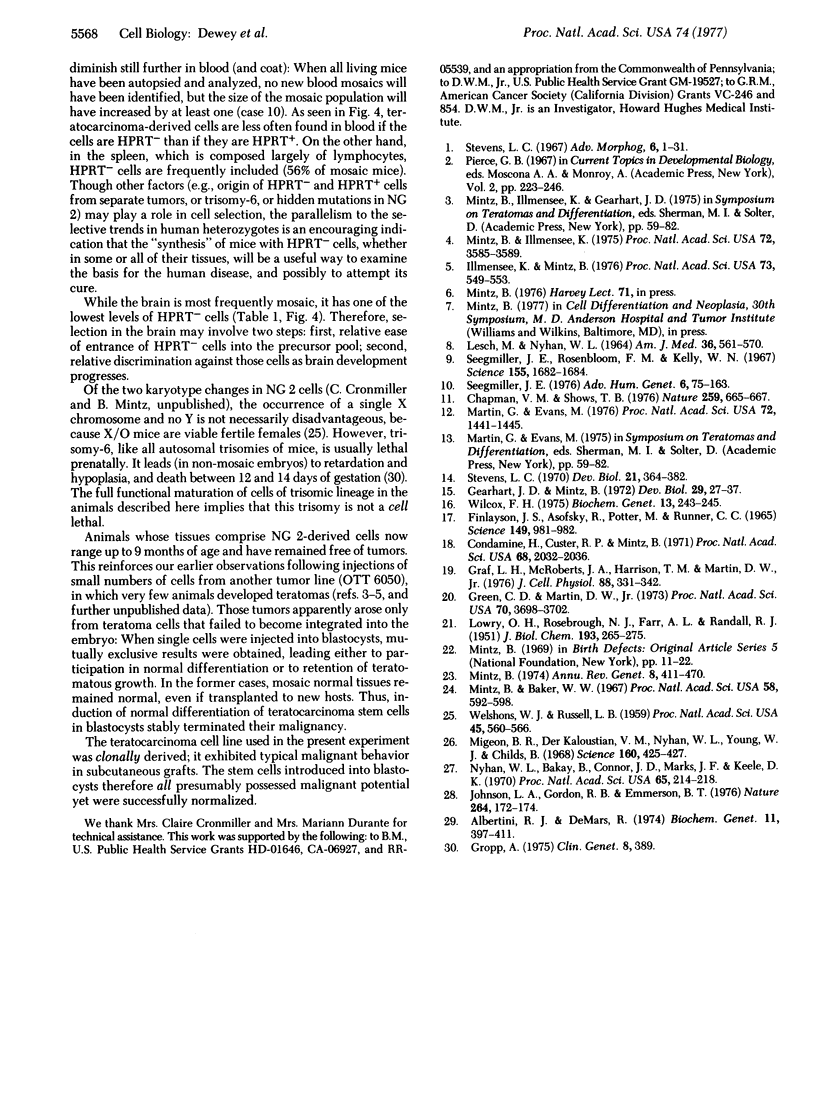Abstract
Mutagenized stem cells of a cultured mouse teratocarcinoma cell line were selected for resistance to the purine base analog 6-thioguanine. Cells of a resistant clone were completely deficient in activity of the enzyme hypoxanthine phosphoribosyltransferase (HPRT, IMP:pyrophosphate phosphoribosyltransferase, EC 2.4.2.8), the same X-linked lesion as occurs in human Lesch-Nyhan disease. After microinjection into blastocysts of another genetic strain, the previously malignant cells successfully participated in normal embryogenesis and tumor-free, viable mosaic mice were obtained. Cells of tumor lineage were identified by strain markers in virtually all tissues of some individuals. Mature function of those cells was evident from their tissue-specific products (e.g., melanins, liver proteins). These mutagenized teratocarcinoma cells are therefore developmentally totipotent. Retention of the severe HPRT deficiency in the differentiated state was documented in extracts of mosaic tissues by depressed specific activity of the enzyme, and also by presence of unlabeled clones in autoradiographs of explanted cells incubated in [3H]hypoxanthine. Some mosaic individuals had mutant-strain cells in only one or a few tissues. Such animals may provide unique opportunities to identify the tissue sources of particular aspects of the complex disease syndrome. The tissue distribution of HPRT-deficient cells suggests that selection against them is particularly strong in blood of the mosaic mice, as is already known to be the case in human heterozygotes. This phenotypic parallelism supports the expectation that afflicted F1 male mice that might be obtained from mutant germ cells can serve as a model of the human disease.
Keywords: Lesch-Nyhan disease, cell selection, trisomy, allophenic mice, blastocyst injection
Full text
PDF




Images in this article
Selected References
These references are in PubMed. This may not be the complete list of references from this article.
- Albertini R. J., DeMars R. Mosaicism of peripheral blood lymphocyte populations in females heterozygous for the Lesch-Nyhan mutation. Biochem Genet. 1974 May;11(5):397–411. doi: 10.1007/BF00486413. [DOI] [PubMed] [Google Scholar]
- Chapman V. M., Shows T. B. Somatic cell genetic evidence for X-chromosome linkage of three enzymes in the mouse. Nature. 1976 Feb 26;259(5545):665–667. doi: 10.1038/259665a0. [DOI] [PubMed] [Google Scholar]
- Condamine H., Custer R. P., Mintz B. Pure-strain and genetically mosaic liver tumors histochemically identified with the -glucuronidase marker in allophenic mice. Proc Natl Acad Sci U S A. 1971 Sep;68(9):2032–2036. doi: 10.1073/pnas.68.9.2032. [DOI] [PMC free article] [PubMed] [Google Scholar]
- Finlayson J. S., Asofsky R., Potter M., Runner C. C. Major urinary protein complex of normal mice: origin. Science. 1965 Aug 27;149(3687):981–982. doi: 10.1126/science.149.3687.981. [DOI] [PubMed] [Google Scholar]
- Gearhart J. D., Mintz B. Clonal origins of somites and their muscle derivatives: evidence from allophenic mice. Dev Biol. 1972 Sep;29(1):27–37. doi: 10.1016/0012-1606(72)90040-1. [DOI] [PubMed] [Google Scholar]
- Graf L. H., Jr, McRoberts J. A., Harrison T. M., Martin D. W., Jr Increased PRPP synthetase activity in cultured rat hepatoma cells containing mutations in the hypoxanthine-guanine phosphoribosyltransferase gene. J Cell Physiol. 1976 Jul;88(3):331–342. doi: 10.1002/jcp.1040880309. [DOI] [PubMed] [Google Scholar]
- Green C. D., Martin D. W., Jr Characterization of a feedback-resistant phosphoribosylpyrophosphate synthetase from cultured, mutagenized hepatoma cells that overproduce purines. Proc Natl Acad Sci U S A. 1973 Dec;70(12):3698–3702. doi: 10.1073/pnas.70.12.3698. [DOI] [PMC free article] [PubMed] [Google Scholar]
- Illmensee K., Mintz B. Totipotency and normal differentiation of single teratocarcinoma cells cloned by injection into blastocysts. Proc Natl Acad Sci U S A. 1976 Feb;73(2):549–553. doi: 10.1073/pnas.73.2.549. [DOI] [PMC free article] [PubMed] [Google Scholar]
- Johnson L. A., Gordon R. B., Emmerson B. T. Two populations of heterozygote erythrocytes in moderate hypoxanthine guanine phosphoribosyltransferase deficiency. Nature. 1976 Nov 11;264(5582):172–174. doi: 10.1038/264172a0. [DOI] [PubMed] [Google Scholar]
- LESCH M., NYHAN W. L. A FAMILIAL DISORDER OF URIC ACID METABOLISM AND CENTRAL NERVOUS SYSTEM FUNCTION. Am J Med. 1964 Apr;36:561–570. doi: 10.1016/0002-9343(64)90104-4. [DOI] [PubMed] [Google Scholar]
- LOWRY O. H., ROSEBROUGH N. J., FARR A. L., RANDALL R. J. Protein measurement with the Folin phenol reagent. J Biol Chem. 1951 Nov;193(1):265–275. [PubMed] [Google Scholar]
- Martin G. R., Evans M. J. Differentiation of clonal lines of teratocarcinoma cells: formation of embryoid bodies in vitro. Proc Natl Acad Sci U S A. 1975 Apr;72(4):1441–1445. doi: 10.1073/pnas.72.4.1441. [DOI] [PMC free article] [PubMed] [Google Scholar]
- Migeon B. R., Der Kaloustian V. M., Nyhan W. L., Yough W. J., Childs B. X-linked hypoxanthine-guanine phosphoribosyl transferase deficiency: heterozygote has two clonal populations. Science. 1968 Apr 26;160(3826):425–427. doi: 10.1126/science.160.3826.425. [DOI] [PubMed] [Google Scholar]
- Mintz B., Baker W. W. Normal mammalian muscle differentiation and gene control of isocitrate dehydrogenase synthesis. Proc Natl Acad Sci U S A. 1967 Aug;58(2):592–598. doi: 10.1073/pnas.58.2.592. [DOI] [PMC free article] [PubMed] [Google Scholar]
- Mintz B. Gene control of mammalian differentiation. Annu Rev Genet. 1974;8:411–470. doi: 10.1146/annurev.ge.08.120174.002211. [DOI] [PubMed] [Google Scholar]
- Mintz B., Illmensee K. Normal genetically mosaic mice produced from malignant teratocarcinoma cells. Proc Natl Acad Sci U S A. 1975 Sep;72(9):3585–3589. doi: 10.1073/pnas.72.9.3585. [DOI] [PMC free article] [PubMed] [Google Scholar]
- Nyhan W. L., Bakay B., Connor J. D., Marks J. F., Keele D. K. Hemizygous expression of glucose-6-phosphate dehydrogenase in erythrocytes of heterozygotes for the Lesch-Nyhan syndrome. Proc Natl Acad Sci U S A. 1970 Jan;65(1):214–218. doi: 10.1073/pnas.65.1.214. [DOI] [PMC free article] [PubMed] [Google Scholar]
- Seegmiller J. E. Inherited deficiency of hypoxanthine-guanine phosphoribosyltransferase in X-linked uric aciduria (the Lesch-Nyhan syndrome and its variants). Adv Hum Genet. 1976;6:75–163. doi: 10.1007/978-1-4615-8264-9_2. [DOI] [PubMed] [Google Scholar]
- Seegmiller J. E., Rosenbloom F. M., Kelley W. N. Enzyme defect associated with a sex-linked human neurological disorder and excessive purine synthesis. Science. 1967 Mar 31;155(3770):1682–1684. doi: 10.1126/science.155.3770.1682. [DOI] [PubMed] [Google Scholar]
- Stevens L. C. The biology of teratomas. Adv Morphog. 1967;6:1–31. doi: 10.1016/b978-1-4831-9953-5.50005-6. [DOI] [PubMed] [Google Scholar]
- Stevens L. C. The development of transplantable teratocarcinomas from intratesticular grafts of pre- and postimplantation mouse embryos. Dev Biol. 1970 Mar;21(3):364–382. doi: 10.1016/0012-1606(70)90130-2. [DOI] [PubMed] [Google Scholar]
- Welshons W. J., Russell L. B. THE Y-CHROMOSOME AS THE BEARER OF MALE DETERMINING FACTORS IN THE MOUSE. Proc Natl Acad Sci U S A. 1959 Apr;45(4):560–566. doi: 10.1073/pnas.45.4.560. [DOI] [PMC free article] [PubMed] [Google Scholar]
- Wilcox F. H. Simplified procedure for electrophoresis of the major urinary protein of Mus musculus. Biochem Genet. 1975 Apr;13(3-4):243–245. doi: 10.1007/BF00486018. [DOI] [PubMed] [Google Scholar]




